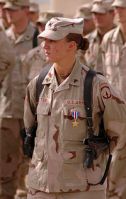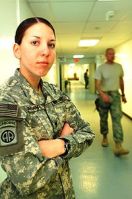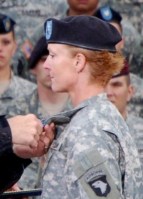
Hester

Brown

Hill
Let the generations know that women in uniform also guaranteed their freedom. That our resolve was just as great as the brave men who stood among us. And with victory our hearts were just as full and beat just as fast – that the tears fell just as hard for those we left behind.
— World War II Army Nurse.
Those thoughts are etched in glass at the Women in Military Service for America Memorial just outside Arlington Cemetery. Military heroes are often defined by the awards they are given for bravery and courage in the face of battle. Many ordinary military personnel have exhibited extraordinary bravery under conditions other than direct combat, but may not have been recognized for awards. This is very common for women, since most women, until recently, have not had a hand in the offensive operations of war. However, the military could not perform its mission of offensive combat without the support of people “behind the lines.” And because there is a “tooth to tail” ratio of 20:80, which means that only about 20% of soldiers in the Army are combat warriors, and the other 80% are combat support or combat service support, the “teeth” of the military are held in higher esteem than their comrades.
Nevertheless, women have won awards for heroism, have suffered through being prisoners of war, and they are dying for their country in Iraq and Afghanistan. The highest award given to any woman in the last 10 years of combat is the Silver Star. In 2005, Sergeant Leigh Ann Hester, vehicle commander, 617th Military Police Company, Kentucky National Guard, became the first woman to receive the Silver Star award for close quarters combat. Ambushed by insurgents, Hester led her team through the kill zone into a flanking position, where she assaulted a trench line with grenades. She and her squad leader, Staff Sergeant Timothy F. Nein, then assaulted and cleared two trenches. She also killed at least three enemy combatants with her rifle. When the battle was over, 27 insurgents were dead, six were wounded, and one captured. In part, her citation reads that her actions “saved the lives of numerous convoy members.”
In March 2008, Silver Star recipient, Army Specialist Monica Lin Brown, received the Silver Star for combat in Afghanistan. Brown’s heroism was evident while providing aid under heavy gunfire to soldiers whose Humvee had been hit by an improvised explosive device (IED) during a convoy. A medic, and only 18 at the time, Brown left the safety of her Humvee to give aid to Specialists Stanson Smith and Larry Spray, who both had suffered life-threatening injuries. With the help of her platoon sergeant, Staff Sergeant Jose Santos, and three other less wounded soldiers from the vehicle, Brown eventually was able to move Smith and Spray away from the burning vehicle. When rounds of ammunition from the truck began exploding, Brown sheltered the injured with her body. She and Santos were finally able to escape the gunfire and mortar rounds and get the injured to a more stable area, where she continued rendering aid until medical evacuation. Both Smith and Spray survived their injuries.
Chief Warrant Officer 3 Lori Hill is the first military woman to be awarded the Distinguished Flying Cross for heroism. In March 2006, Hill and another helicopter were flying convoy security for two Bradley vehicles on patrol in a small village. They learned of an attack at a nearby command center involving both U.S. and Iraqi forces, so they responded to provide air support. On the way they ran into a concentrated attack with rocket propelled grenades and machine gun fire. They laid down suppressing fire but the two aircraft continued on. When they arrived at the command center, they were greeted with machine gun fire, so they broke away and headed back in, shooting at the tracer fire. Drawing the fire away from the lead helo, Hill established communications with the ground troops, and provided suppressive fire for troops engaged with the enemy on the ground until they reached safety. On the third pass, a rocket-propelled grenade hit her, damaging the helo’s instrumentation. As she was banking away, the helo took machine gun fire which hit Hill in the foot. The aircraft was losing transmission power, as well as hydraulics, which prevented the copter from hovering, a crucial maneuver for landing. So, with a damaged aircraft and injury, she made an emergency landing at a nearby forward operating base, saving her crew and aircraft.
Women have also suffered and perished as prisoners of war. During the Civil War, women who were spies as well as soldiers (once they were discovered to be female) were usually traded back to their side with the understanding they would not re-emerge as combatants. Other women have not been so lucky. There were 83 women who were POWs during World War II, two during Desert Storm, and three during the first phase of Operation Iraqi Freedom.
Over 140 military women have given their lives for their country in the last 10 years. If killed or wounded in action, they receive the Purple Heart. One of the most famous wounded warriors is Tammy Duckworth, who went on to serve as an assistant secretary of the Department of Veterans Affairs. She lost the lower parts of both her legs when a rocket-propelled grenade hit the helicopter she was co-piloting over Iraq in 2004.
There are legions of these kinds of women. And while no other woman has been awarded the Silver Star since 2008, they continue to serve in harm’s way, every day. Sergeant Hester says her medal “doesn’t have anything to do with being female. It’s about the duties I performed that day as a soldier.” Which is true…but one has to wonder about the dearth of female medal winners. Just like their male comrades, they’re putting it all on the line in the service of our country.


